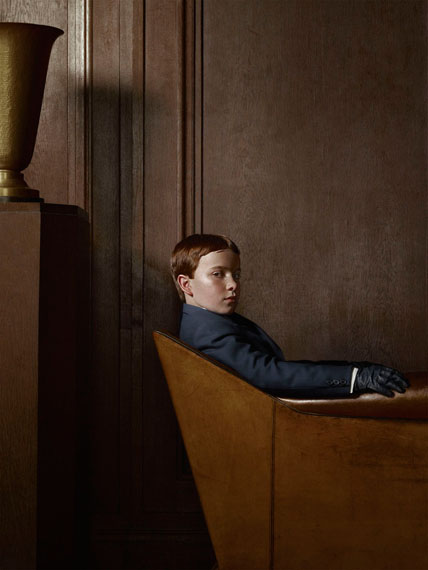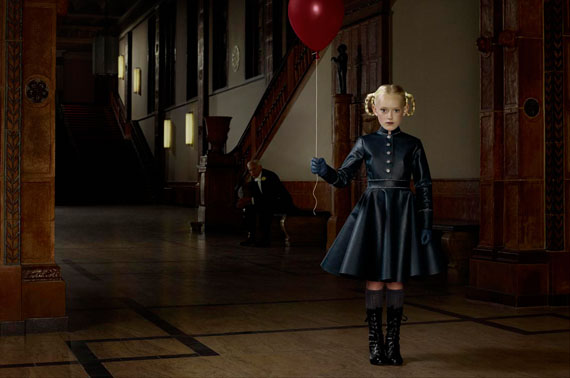
Chromogenic print
Large format, edition of 10: 47 1/4 x 35 3/8 in. (120 x 90 cm.)
Small format, edition of 10: 29 1/2 x 22 in. (75 x 56 cm.)
© Erwin Olaf
Erwin Olaf »
Berlin
Exhibition: 7 Mar – 10 May 2013

Hamiltons
13 Carlos Place
W1K 2EU London
+44 (0)20-74999494
art@hamiltonsgallery.com
www.hamiltonsgallery.com
Mon-Fri 10-18, Sat 11-16

Chromogenic print
Large format, edition of 10: 47 1/4 x 35 3/8 in. (120 x 90 cm.)
Small format, edition of 10: 29 1/2 x 22 in. (75 x 56 cm.)
© Erwin Olaf
Hamiltons Gallery presents Erwin Olaf’s newest series of work, ‘Berlin’: In a significant departure from his previous projects, ‘Berlin’ is set and filmed on location in six different historical locations of the grand city, rather than imagined and constructed in Olaf’s Amsterdam studio.
Funded in part with the proceeds of his 2011 Vermeer prize, the most important cultural recognition conferred by the Dutch government, this series demonstrates that Erwin Olaf has again broken the boundaries of contemporary photographic practice. At once historical and contemporary, with a tension-filled, and ever-shifting narrative, Olaf manages to entrance, perplex, confound and delight viewers with a powerful range of imagery.
Francis Hodgson, in his essay exploring ‘Berlin’, comments:
‘You could see Berlin as an opera. There are the grand elements from history, which are like the bits of legend or myth or biblical story that make up the plots of opera. Here are some of them: The Neue Sachlichkeit (the New Objectivity, an art-history label for the harsh realism of painters such as Otto Dix or Christian Schad). Here’s the building where John Kennedy called himself a Berliner (“lift your eyes beyond the dangers of today, to the hopes of tomorrow, beyond the freedom merely of this city of Berlin, or your country of Germany, to the advance of freedom everywhere..”). Here is a broad hinted reminder of the great Jesse Owens, carrying off the plaudits at Hitler’s own Olympiad, and making a mockery of the Chancellor’s racism in doing so. Here’s the peculiar sub-culture of the duelling clubs, there’s a kid who looks uncomfortably like an enthusiastic recruit to the Hitler Youth, with his slicked hair and his black leather gloves. These are concrete references but not deployed to be specific. Olaf uses them to take us through a range of moods, exactly as opera does. We don’t need an exact narrative because so many of the historical references are so clear. Instead we get a set of pictures just imbued with Berlin.’�

Chromogenic print
Large format, edition of 10: 47 1/4 x 71 1/4 in. (120 x 181 cm.)
Small format, edition of 10: 23 5/8 x 35 3/8 in. (60 x 90 cm.)
© Erwin Olaf
In addition to Olaf’s large format colour prints on view at Hamiltons, there is something new to his oeuvre: small format carbon prints, which he made himself, each a small gem and unique in tonality and appearance. These are special and mesmerizing objects, imbued with the eye of an artist and the hands of a craftsman. Each made in a tiny edition of only 3 prints, and printed using an almost extinct photographic process, the images are reconstituted, providing the viewer with a perception of the past, even while still securely anchored in the present.
‘Erwin Olaf: Berlin’ will be accompanied by an exhibition catalogue containing essays by Francis Hodgson, and Maartje van der Heuvel, of the University of Leiden.
An artists’ talk, given in conjunction with the University of Westminster, is planned for a central London location on Wednesday 6 March; please enquire for further details.

Chromogenic print
Large format, edition of 10: 47 1/4 x 71 1/4 in. (120 x 181 cm.)
Small format, edition of 10: 23 5/8 x 35 3/8 in. (60 x 90 cm.)
© Erwin Olaf